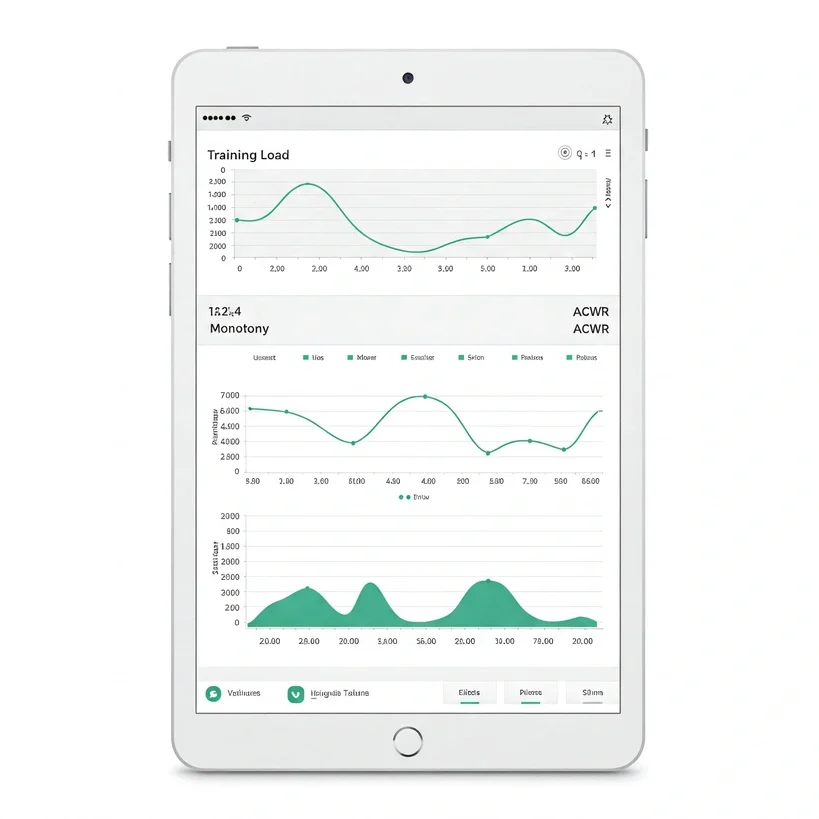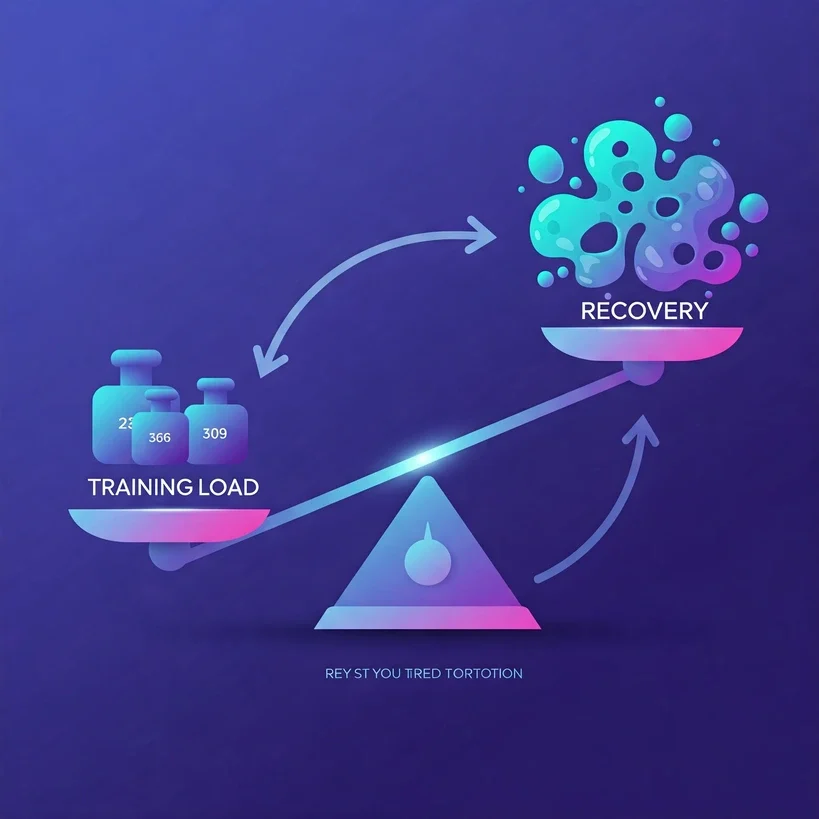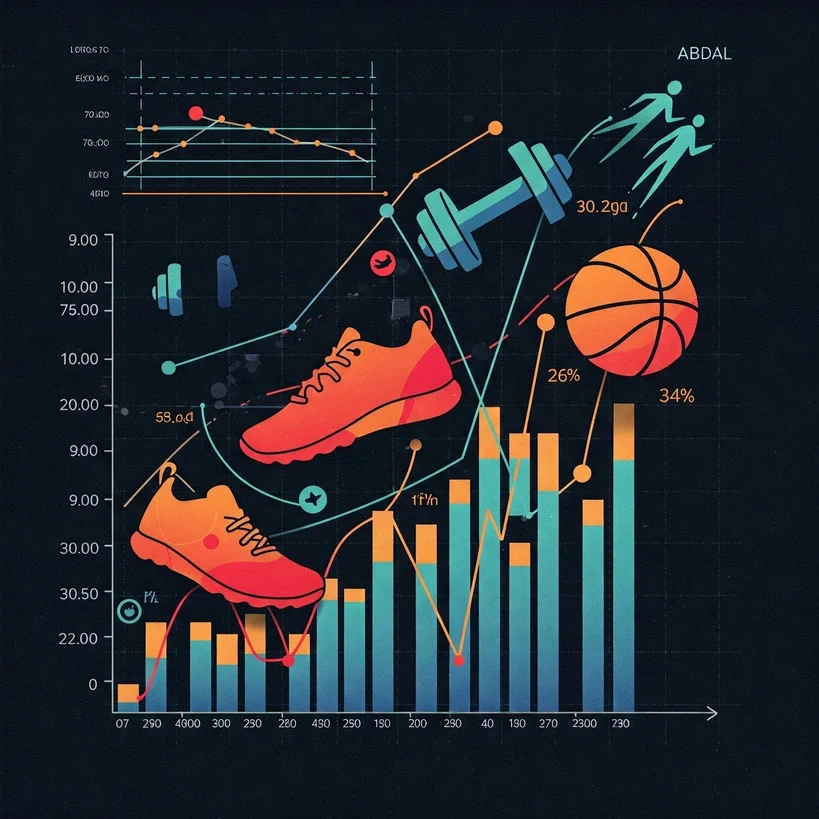Introduction: Navigating the Training Balancing Act
Every athlete and coach faces a fundamental challenge: how to apply enough training stimulus to drive performance improvements without crossing the line into excessive fatigue, injury, or overtraining. This delicate balance is key to consistent progress and long-term success in any sport.
Effective training load monitoring provides the crucial insights needed to manage this balance. By tracking the stress placed on the athlete over time, we can make informed decisions about future training sessions, recovery needs, and overall programming.
Why Monitor Training Load?
Monitoring training load is far more than just logging miles or hours. It’s about understanding the physiological and psychological stress of training. Consistent and smart monitoring is a primary tool for Overtraining Prevention Training Load strategies.
Without objective data, coaches and athletes often rely solely on subjective feelings, which can be misleading. Structured load monitoring helps identify patterns, predict potential issues, and optimize the timing of harder efforts and recovery periods.
Key Metrics for Workload Management
Several key metrics have emerged to help quantify and interpret training load. This guide will delve into the calculation and meaning of Training Monotony, Training Strain, and the Acute to Chronic Workload Ratio (ACWR).
Understanding how to perform a proper Training Monotony Calculation is foundational. Similarly, learning to Calculate Training Strain provides a valuable metric that combines both load and its variability. While ACWR is widely used, we will also touch upon the complexities and Acute Chronic Workload Ratio Limitations.
What This Guide Covers
In the following chapters, we will break down these concepts step-by-step. We’ll explore the formulas, discuss practical tools like the Training Load Monitoring Spreadsheet, interpret what the numbers mean in real-world scenarios, and look at how these traditional metrics are evolving with newer research.
Our goal is to provide you with the knowledge to effectively monitor training load, helping you optimize performance and minimize risk.
Chapter 1: Understanding Training Load – The Foundation
Before we dive into specific metrics like monotony or strain, it’s essential to grasp the core concept of training load. Simply put, training load refers to the stimulus, stress, or work placed upon an athlete during training or competition.
Training load isn’t a single, simple number because it has multiple dimensions and effects. It can be broadly categorized into two types: external and internal load.
External vs. Internal Load
External load quantifies the work performed independent of the athlete’s internal response. It’s objective and the same for anyone completing the identical task. Examples include distance covered, weight lifted, speed, or duration of a session.
Internal load, on the other hand, measures the athlete’s individual physiological and psychological response to the external work. This is highly variable between individuals, even when performing the same external task. Heart rate response, lactate levels, and perceived exertion are common measures of internal load.
Common Proxies for Measuring Load
Since measuring every aspect of load is impractical, we use “proxies” – indicators that provide a good estimate of the stress applied. These can come from both external and internal measures.
- Session Duration: The total time spent training. A simple volume proxy.
- Distance/Volume: Total kilometers run, meters swam, weight lifted (sets x reps x load).
- Intensity Measures: Speed, pace, heart rate zones, power output (cycling), percentage of 1-rep max.
- Rate of Perceived Exertion (RPE): A subjective scale (commonly 1-10) where the athlete rates how hard the session felt. When multiplied by session duration, this gives Session-RPE (sRPE), a popular internal load metric.
- TRaining IMPulse (TRIMP): Another internal load metric often calculated using heart rate and session duration. Various formulas exist, but the goal is to quantify the physiological stress.
Metrics like sRPE and TRIMP are particularly useful because they combine an element of intensity (via perception or heart rate) with duration, providing a single value representative of the session’s overall physiological cost. These daily load values are the crucial building blocks for calculating metrics like Training Monotony and Training Strain.
Beyond Volume and Intensity: The Multi-Factorial Nature
While volume and intensity are primary components, training load is truly multifactorial. Factors like training frequency (how many sessions per week), density (how compact the sessions are within a period), and even load orientation (the type or specificity of the training stimulus – e.g., endurance vs. strength vs. technical drills) all contribute to the overall stress and adaptation.
Recognizing this complexity is key to effective workload management. Monitoring different facets of load provides a more complete picture than relying on just one or two metrics alone.
Chapter 2: Training Monotony Explained: Not About Boredom
When we talk about training monotony in the context of sports science, we’re not referring to how interesting or enjoyable a training session is. Instead, Training Monotony is a quantifiable measure reflecting the similarity of daily training load values over a given period, typically a rolling seven-day week.
A training program with high monotony features very little variation in the stress applied from one day to the next. Conversely, a program with low monotony shows significant differences in daily training load, incorporating hard efforts, easy days, and rest days.
Why High Monotony is Detrimental
While consistency is important, excessive similarity in daily training stress is a recognized risk factor for athletes. It can prevent the body from adequately recovering and adapting, ultimately hindering progress.
High training monotony contributes to accumulated fatigue because the athlete is exposed to a very similar stress pattern repeatedly without sufficient variation for specific recovery processes to occur. This consistent, undifferentiated stress can lead to reduced performance benefits, stagnation, and increased susceptibility to illness and injury.
Research has long linked a lack of variety in training stress, or high monotony, to increased risk of Overtraining Syndrome. Effective Overtraining Prevention Training Load strategies actively manage monotony to ensure adequate variation and recovery.
Monotony and Supercompensation
The principle of supercompensation states that following a training stimulus, the body recovers and adapts to a level slightly higher than before. This adaptation requires sufficient rest after the stress is applied.
A training program with low monotony, incorporating planned hard days followed by easier days or rest, facilitates this supercompensation cycle. The varied stress patterns allow for targeted recovery and adaptation.
However, when training is highly monotonous, the body is subjected to similar stress day after day. This can interfere with the recovery process, preventing optimal adaptation and leading to a build-up of fatigue rather than a boost in fitness. Understanding this metric through Training Monotony Calculation is therefore vital for designing effective programs.
Chapter 3: How to Calculate Training Monotony (Foster’s Method)
Now that we understand what training monotony is and why it’s important, let’s look at how it’s traditionally calculated. The most widely referenced method was proposed by Foster, relying on the variability of daily training load.
To perform a Training Monotony Calculation using Foster’s method, you first need daily training load values for a specific period, typically a rolling seven-day week. These daily values can come from metrics like sRPE or TRIMP, as discussed in Chapter 1.
The Calculation Steps
For any given seven-day period, follow these steps:
- Record or calculate the training load value for each of the seven days. If there are multiple sessions in a day, sum their loads for a single daily value.
- Calculate the arithmetic average (mean) of these seven daily load values. This represents your average daily training load for that week.
- Calculate the standard deviation of these seven daily load values. The standard deviation measures how spread out the daily loads are from the average – a higher standard deviation means more variability.
- Divide the average daily load by the standard deviation of the daily loads.
The Formula
Foster’s original Training Monotony formula is expressed as:
Monotony = (Average Daily Load) / (Standard Deviation of Daily Load)
As you can see, the higher the average load relative to the variability (standard deviation), the higher the monotony value. A low standard deviation relative to the average results in high monotony.
Interpreting the Monotony Score
Based on research using this method, general guidelines for interpreting the monotony score have been suggested. Values above 2.0 are often considered high and potentially problematic, indicating excessive similarity in daily training stress. Values below 1.5 are generally seen as preferable, suggesting a healthier level of training variation.
It’s worth noting a potential quirk in the original formula: if the standard deviation is zero (meaning the daily load was exactly the same every day for the week), the formula involves division by zero, resulting in an undefined or infinite monotony. While practically rare in varied training, some approaches suggest alternative calculations or caps to address this sensitivity.
Applying the Calculation
Implementing this calculation manually for each rolling week can be time-consuming. This is why many athletes and coaches utilize tools like a Training Load Monitoring Spreadsheet or dedicated software, which can automate the Foster’s Monotony Calculation based on daily load inputs.
Once you have your monotony score, you’re ready to combine it with total load to understand the overall Training Strain, which we will cover next.
Chapter 4: Beyond Monotony: Calculating Training Strain
While Training Monotony tells us about the consistency of your training stress, it doesn’t tell us about the total amount of stress. A week of very easy, identical sessions could have high monotony but low overall stress. To get a better picture of the cumulative impact, we combine total load with monotony to Calculate Training Strain.
Training Strain is a metric designed to quantify the overall training stress an athlete is undergoing, factoring in both the total volume/intensity and the variability (or monotony) of that load. It acknowledges that a high training volume is more taxing if it’s delivered monotonously compared to a volume spread across varied intensity sessions and recovery days.
The Calculation
Calculating Training Strain is straightforward once you have your daily training load values and the Monotony score for a given period (typically the same rolling seven-day week used for monotony).
First, sum up all the daily training load values for the seven-day period. This gives you the Total Weekly Load.
Next, multiply this Total Weekly Load by the Training Monotony score you calculated in Chapter 3.
The Formula
The formula for Training Strain is:
Training Strain = (Sum of Daily Loads) * (Training Monotony)
Using a Training Load Monitoring Spreadsheet makes this calculation efficient, as it can automatically sum your daily loads and apply the multiplication with your pre-calculated monotony score.
Why Training Strain is a Key Metric
Training Strain provides a more nuanced view of workload than total load alone. For instance, two athletes might complete the exact same total volume or sum of sRPE points in a week, but their Training Strain could be vastly different.
If Athlete A performs highly varied sessions with planned hard days and easy recovery days (low monotony), their strain score for that total load will be lower. If Athlete B performs similar moderate efforts every single day (high monotony), their strain score for the same total load will be significantly higher.
This higher strain value reflects the greater physiological and psychological cost associated with monotonous training, aligning with the increased risk of fatigue and overtraining we discussed earlier. Monitoring Strain helps coaches and athletes understand the true impact of their training structure.
Chapter 5: The Acute to Chronic Workload Ratio (ACWR)
Beyond looking at the variability within a single week (Monotony) or the combined weekly stress (Strain), training load monitoring often involves comparing short-term workload to long-term workload. This is the purpose of the Acute to Chronic Workload Ratio, or ACWR.
The ACWR is a widely used metric designed to assess an athlete’s recent training load relative to their established training base. The idea is to understand if the current training intensity and volume represent a significant spike compared to what the athlete has been consistently doing.
Defining Acute and Chronic Workload
- Acute Workload: This is typically the sum of training load for the most recent seven-day period (e.g., the current week).
- Chronic Workload: This represents the athlete’s training “base” or preparedness. It’s commonly calculated as the average daily load over a longer period, most often the preceding 28 days (four weeks).
The chronic workload provides context for the acute workload. A high training day or week for a well-trained athlete with a high chronic base is less likely to cause issues than the same high load for an athlete with a low chronic base.
Calculating the ACWR
The ACWR is calculated by dividing the Acute Workload by the Chronic Workload:
ACWR = (Acute Workload) / (Chronic Workload)
There are two primary methods for calculating the Chronic Workload component:
- Rolling Average: The chronic workload is simply the arithmetic mean of the total weekly loads over the past four weeks (including, or sometimes excluding, the current acute week).
- Exponentially Weighted Moving Average (EWMA): This method assigns greater weighting to more recent training loads within the chronic window, making the chronic value more responsive to recent changes in training volume.
Implementing these calculations, especially EWMA, is typically done using a Training Load Monitoring Spreadsheet or specialized software.
Interpreting the ACWR: The ‘Sweet Spot’ Concept
Much of the research surrounding ACWR has focused on its potential relationship with injury risk. A commonly cited interpretation suggests a “sweet spot” or optimal range for the ratio, often stated as being between 0.8 and 1.3. Ratios within this range are theoretically associated with building fitness while minimizing injury risk.
Conversely, a ratio significantly above this range (commonly cited as > 1.5) is often referred to as the “danger zone,” associated with a theoretically increased risk of non-contact injury due to sudden spikes in workload.
However, it is important to note that the interpretation and predictive power of the ACWR, particularly regarding injury risk, have been the subject of considerable debate and scientific scrutiny. We will explore some of these Acute Chronic Workload Ratio Limitations in a later chapter.
Chapter 6: Tools and Resources for Tracking Your Workload
Successfully monitoring training load and calculating metrics like Monotony, Strain, and ACWR requires consistent data collection. Fortunately, numerous tools are available today, ranging from simple manual methods to sophisticated software and wearable technology.
Manual Training Logs
The most basic method is keeping a manual training log or journal. You can record details like the type of activity, duration, perceived exertion (RPE), distance, and notes on how you felt. This provides a qualitative and basic quantitative record.
While simple and low-cost, calculating metrics like Training Monotony or Strain manually from a paper log can be cumbersome and prone to errors, especially over long periods or for complex formulas like ACWR EWMA.
Training Load Monitoring Spreadsheets
A highly popular and versatile tool is the Training Load Monitoring Spreadsheet. Using software like Microsoft Excel, Google Sheets, or similar programs, you can create a custom system to input daily load data (like sRPE or TRIMP) and automate the calculation of metrics.
Spreadsheets allow for flexibility in tracking various load proxies and can automatically perform the calculations for Training Monotony Calculation, Calculate Training Strain, and ACWR. Many free templates are available online, or you can build one tailored to your specific needs. This provides a powerful, customizable, and relatively inexpensive solution.
Dedicated Software and Platforms
Numerous online platforms and desktop software applications are specifically designed for athlete training load monitoring. Examples include TrainingPeaks, WKO, and features within platforms like Garmin Connect or Strava (though feature sets vary).
These tools often integrate with GPS devices and heart rate monitors to automatically import external load data. They then calculate various internal and external load metrics, including Monotony and ACWR, and provide advanced visualization and analysis tools. They significantly reduce the manual data entry and calculation burden.
Wearable Technology
Modern wearable technology plays a vital role in collecting the data needed for load monitoring. GPS watches, heart rate monitors (chest straps or wrist-based), and power meters directly capture external and some internal load data.
Devices that track Heart Rate Variability (HRV) offer another layer of monitoring, providing insights into the athlete’s recovery status and autonomic nervous system response, which complements objective load metrics in understanding the overall picture for effective Overtraining Prevention Training Load.
Choosing the right tools depends on your budget, technical proficiency, and specific monitoring needs. The most important factor is selecting a system you can use consistently to collect accurate data.
Chapter 7: Interpreting Your Metrics & Practical Application
Calculating Training Monotony, Strain, and ACWR is the first step. The real value comes from interpreting these numbers in the context of an individual athlete and using them to guide training decisions. These metrics are tools to inform, not dictate, your training process.
Seeing the Numbers in Practice (Conceptual Examples)
Recall the calculations from Chapters 3 and 4. Imagine two athletes with the exact same total weekly training load (e.g., same sum of sRPE or TRIMP points). Athlete A performed very similar sessions each day, resulting in high monotony and consequently high Training Strain.
Athlete B, however, structured their week with planned hard days, easy recovery days, and perhaps a full rest day. Their daily load variability was high, resulting in low monotony and lower Training Strain, despite the same total weekly load. This illustrates how structure impacts stress perception and recovery needs.
Interpreting Monotony and ACWR Scores: Common Guidelines
Based on research and practical experience, some general guidelines exist for interpreting Training Monotony and ACWR:
- Training Monotony: Scores above 2.0 are often seen as high, suggesting insufficient variation and potential risk. Scores below 1.5 are generally considered favorable, indicating better variability.
- ACWR (‘Sweet Spot’): A ratio between 0.8 and 1.3 has been traditionally associated with favorable training adaptation and lower injury risk. Ratios above 1.5 are commonly linked to increased theoretical risk due to sudden workload spikes.
Important Caveat: Metrics are Indicators, Not Deterministic Predictors. While these ranges provide a starting point, it is absolutely crucial to understand their limitations. As highlighted by recent research, metrics like ACWR, particularly their direct link to injury prediction, are subject to ongoing debate and are not universally predictive. Average guideline values can be misleading when applied rigidly to individuals.
Context, Individualization, and Additional Factors
Effective interpretation must be highly individualized and consider numerous factors beyond the numbers:
- Athlete Feedback: How does the athlete feel? Are they reporting fatigue, soreness, poor sleep, or low motivation? Subjective feedback is paramount.
- Wellness Markers: Track sleep quality/duration, stress levels (work, life), nutrition, and mood. Metrics like HRV (Heart Rate Variability) can also provide objective insight into recovery status.
- Training History & Sport Specificity: An athlete’s experience level and the demands of their specific sport significantly influence how they tolerate load and monotony.
- Performance Outcomes: Are performance markers improving, plateauing, or declining?
These metrics are powerful when used as part of a holistic monitoring system, helping to identify potential issues early and inform coaching decisions for Overtraining Prevention Training Load strategies. They help confirm or question subjective feelings and wellness data.
Using Metrics to Guide Training
Understanding your Monotony, Strain, and ACWR can help you:
- Plan weekly load variation more effectively.
- Ensure adequate recovery periods after high-monotony or high-strain weeks.
- Identify periods of high ACWR that might warrant closer observation or deloading.
- Refine your periodization to balance periods of higher load/potential strain (when needed for adaptation) with periods of lower load and higher variability.
Remember, the goal is to use these insights to optimize the training stimulus for continuous improvement while maintaining health and consistency.
Chapter 8: Critiques and Evolving Concepts
The metrics we’ve discussed – Training Monotony, Strain, and ACWR – provide valuable insights and are widely used for Training Load Monitoring. However, the scientific understanding of training load is constantly evolving, and researchers have pointed out some key limitations of these traditional models.
Limitations of Traditional Metrics
A primary critique, highlighted in recent research (like the Afonso et al. paper from 2021), is that metrics based solely on proxies like sRPE, TRIMP, distance, or duration primarily capture the volume and intensity of training. While important, this provides an incomplete picture of the total stress and its adaptive effects.
These traditional models often fail to adequately account for other crucial dimensions of training load, such as frequency, density, complexity, and critically, Load Orientation.
The Importance of Load Orientation
Load Orientation refers to the specific nature or type of stimulus applied during training. It considers what kind of training was performed, not just how much or how hard it felt overall. Examples of different load orientations include:
- Physical (e.g., Strength, Endurance, Speed, Agility)
- Technical (e.g., Analytical Drills, Contextual Skill Practice)
- Tactical (e.g., Small-Sided Games, Simulated Match Play)
- Psychological (e.g., High-pressure scenarios, Cognitive tasks under fatigue)
Why does orientation matter? Two training sessions could theoretically result in the exact same sRPE or TRIMP value (similar perceived volume/intensity), but one could be heavy weightlifting while the other is a long, easy run. The physiological adaptations and specific stress applied are fundamentally different. Traditional Monotony and ACWR calculations based on these proxies might show low monotony because the numbers are similar, but the athlete is experiencing monotonous stress from the type of activity.
Ignoring load orientation means traditional metrics might miss crucial information about the specificity and potential monotony of the stimulus type, even if the overall load proxy varies.
Towards More Comprehensive Metrics: Evolving Concepts
Recognizing these limitations, researchers are developing new conceptual models to provide a more complete picture of training load. For example, the Afonso et al. paper proposed new indices like the Intraweek Training Monotony (ITM) and Acute Chronic Workload Index (ACWI).
These newer models aim to integrate factors like load orientation, session duration, weekly density, and chosen load metrics into a single framework. Their goal is to provide metrics that are more sensitive to the qualitative aspects of training variation and progression.
The development of metrics like ITM and ACWI illustrates the ongoing effort to refine how we quantify training stress. They highlight that simply performing a basic Training Monotony Calculation or looking at a standard ACWR may not capture all the relevant information needed for truly optimized monitoring.
ACWR Limitations and Future Directions
As mentioned in Chapter 7, the predictive power of ACWR, particularly regarding injury, has been debated. The critiques around its reliance on volume/intensity and omission of factors like load orientation contribute to these Acute Chronic Workload Ratio Limitations.
The field is moving towards multi-dimensional approaches that combine various load metrics with athlete feedback, wellness data, and a deeper understanding of the type of stress applied. While traditional metrics provide a valuable starting point and are easily accessible, future monitoring may increasingly incorporate the nuances of load orientation and other factors to build more robust models for informing performance and Overtraining Prevention Training Load.
Chapter 9: Strategic Workload Management & Preventing Overtraining
Calculating and interpreting metrics like Training Monotony, Strain, and ACWR gives you powerful data. But the ultimate goal is to use this information strategically to manage training load effectively, optimize performance, and achieve Overtraining Prevention Training Load.
Metrics and Periodization
Periodization is the systematic planning of training to manage fatigue and optimize performance at key times. Effective periodization inherently involves planned variations in training load.
Load monitoring metrics are invaluable tools within a periodized plan. They help ensure that the actual training stimulus aligns with the intended stimulus. For example, are your planned “easy” weeks genuinely reducing Acute Load and ACWR? Are your “hard” blocks showing the intended increase in load without excessive Monotony or Strain unless strategically planned?
Using metrics allows you to confirm if your periodization is having the desired physiological impact or if adjustments are needed.
Planned Variation vs. Unplanned Monotony
As we learned, high monotony is generally detrimental. However, in specific, carefully planned training blocks, a temporary increase in monotony might be necessary to achieve a particular adaptation (e.g., a block focused solely on aerobic base building). This is planned variation over a larger cycle.
The danger lies in unplanned monotony, where week after week looks the same due to a lack of deliberate structure. Monitoring Monotony is key to identifying this rut before it leads to stagnation or negative consequences.
Prioritizing Recovery
Load and recovery are two sides of the same coin. Effective workload management is impossible without prioritizing recovery. Your load monitoring metrics can inform your recovery needs. A week of high Strain, for instance, signals a greater need for rest and recovery afterward.
Key recovery strategies include:
- Adequate Sleep (quantity and quality are crucial)
- Proper Nutrition and Hydration
- Active Recovery (light exercise)
- Mobility and Flexibility Work
- Stress Management Techniques
- Psychological De-loading
Listening to your body and observing wellness markers (as discussed in Chapter 7) alongside your metrics will provide the clearest picture of recovery status.
Recognizing and Preventing Overtraining
One of the most critical applications of load monitoring is reducing the risk of Overtraining Syndrome. While metrics like ACWR have limitations as direct predictors, they are powerful indicators when combined with other information.
Consistently high Monotony, persistently elevated Strain, or repeated spikes in ACWR (especially if not planned) can flag an athlete as being at higher risk. These flags become particularly concerning if they coincide with subjective reports or objective signs of inadequate recovery.
Signs and symptoms of overtraining can vary but often include:
- Persistent Fatigue or Heaviness
- Decreased Performance (despite continued training)
- Increased Resting Heart Rate or Altered HRV
- Increased Susceptibility to Illness or Injury
- Irritability, Mood Swings, or Depression
- Poor Sleep Quality
- Loss of Motivation or Enjoyment
Using a Training Load Monitoring Spreadsheet or software allows you to track trends in your metrics over time and cross-reference them with your wellness and performance data. This proactive approach is the essence of effective Overtraining Prevention Training Load – identifying the warning signs early and adjusting training before a serious issue develops.
Conclusion: Empowering Your Training Journey
Navigating the complexities of training load is fundamental to achieving peak performance while maintaining health. By understanding and monitoring key metrics, you gain objective insights that complement your subjective feel and inform your training decisions.
This guide has walked you through the essentials, from defining training load to calculating and interpreting metrics like Training Monotony, Training Strain, and the Acute to Chronic Workload Ratio (ACWR). We’ve also touched upon the nuances, limitations, and evolving concepts in this dynamic field.
Key Takeaways
Let’s recap some of the most important points:
- Training load is a complex, multi-factorial concept, not just volume and intensity.
- High Training Monotony (lack of variation) is a risk factor for fatigue and overtraining.
- You can perform a Training Monotony Calculation using simple formulas based on daily load data.
- Training Strain combines total load and monotony to show overall stress. Learning to Calculate Training Strain gives a more complete picture.
- ACWR compares current load to your training base, but be mindful of Acute Chronic Workload Ratio Limitations regarding injury prediction; it’s best used as an indicator among others.
- Tools like a Training Load Monitoring Spreadsheet or dedicated software make tracking and calculation much easier.
- Metric interpretation requires individual context, athlete feedback, and attention to recovery and wellness.
- The field is advancing, with newer concepts exploring dimensions like load orientation.
- Strategic workload management is crucial for effective periodization and Overtraining Prevention Training Load.
Take Control of Your Training
Don’t let training load be a mystery. By implementing a consistent monitoring strategy, you empower yourself (or your athletes) to make smarter decisions. Use the metrics discussed here as guides, combine them with how the athlete feels, and observe the trends over time.
Whether you start with a simple manual log, build a Training Load Monitoring Spreadsheet, or invest in specialized software, the important thing is to start tracking. Consistent data over time is invaluable for understanding your individual response to training and optimizing your journey.
Continue learning, keep monitoring, and train smart!
Taking the Next Step: Putting Monitoring into Action
You’ve now explored the fundamental concepts behind training load monitoring, learned how to calculate key metrics like Monotony and Strain, understood the ACWR and its nuances, and seen how these tools can inform your strategic training decisions for Overtraining Prevention Training Load.
Knowledge is powerful, but implementing it is where the real change happens. Here are some practical steps you can take to start effectively monitoring your own (or your athletes’) workload:
Start Tracking Daily Load
Choose a method for consistently recording your daily training load. This could be sRPE for simplicity across different activities, or a more objective measure like TRIMP or total distance/duration if your training is highly consistent (e.g., running or cycling).
Choose Your Tool
Decide which tool fits your needs and technical comfort:
- Manual Log: Simplest start, requires manual calculation.
- Training Load Monitoring Spreadsheet: Cost-effective, highly customizable, allows for automated calculations of Monotony, Strain, and ACWR once set up. Look for downloadable templates or build your own.
- Dedicated Software/Platform: Offers automation, integration with devices, and advanced visualization (e.g., TrainingPeaks, Garmin Connect).
Calculate and Review Metrics Regularly
Commit to calculating your metrics (like Training Monotony Calculation and Calculate Training Strain) at least weekly. Review your ACWR and observe the trends in all your metrics over time. Don’t just look at the numbers in isolation.
Integrate Metrics with Subjective Feedback
Pair your objective numbers with how the athlete feels, wellness data (sleep, stress), and performance observations. Look for correlations and use the metrics to prompt discussions or adjustments.
Refine Your Approach
Load monitoring is an ongoing process. As you gather more data, you’ll better understand your individual responses. Be prepared to refine your metrics, tools, and interpretation based on what you learn.
By consistently applying the principles outlined in this guide, you’ll be well-equipped to navigate the demands of training, optimize adaptation, and minimize risks, moving closer to your full potential.
Acknowledgements & Sources
In creating this comprehensive guide to training load monitoring, we’ve drawn upon established principles and recent scientific insights. Providing reliable, evidence-based information is paramount in sports science, and we wish to acknowledge the valuable resources that informed this content.
Key Resources
Specifically, this guide was significantly shaped by information from the following sources:
-
Practical Explanation of Foster’s Monotony and Strain: A clear breakdown of the traditional methods for calculating Training Monotony and Training Strain, including formulas and practical examples. This resource provided the foundation for our ‘how-to’ chapters on calculating these key metrics.
(Note: A specific link for this practical explanation text was not provided by the user.)
-
Research Paper: New Conceptual Models for Assessing Training Monotony and Acute to Chronic Workload (Afonso et al., 2021). This peer-reviewed study offered critical insights into the limitations of traditional metrics like Foster’s Monotony and ACWR, particularly their omission of load orientation. It also introduced the concept of newer, more multi-dimensional monitoring approaches. This source was crucial for our chapters discussing critiques, interpretation caveats, and evolving concepts.
Read the full paper here (Frontiers in Sports and Active Living)
We encourage you to explore these resources directly for a deeper dive into the topics of training monotony, strain, and advanced workload monitoring concepts.





About the Author
Lost Pace is an ultramarathon runner, shoe-tester and the founder of umit.net. Based year-round in Türkiye’s rugged Kaçkar Mountains, he has logged 10,000 + km of technical trail running and completed multiple 50 K–100 K ultras.
Blending mountain grit with data, Lost analyses power (CP 300 W), HRV and nutrition to craft evidence-backed training plans. He has co-written 260 + long-form guides on footwear science, recovery and endurance nutrition, and is a regular beta-tester of AI-driven coaching tools.
When he isn’t chasing PRs or testing midsoles, you’ll find him sharing peer-reviewed research in plain English to help runners train smarter, stay healthier and finish stronger.
Ultrarunner · Data geek · Vegan athlete

